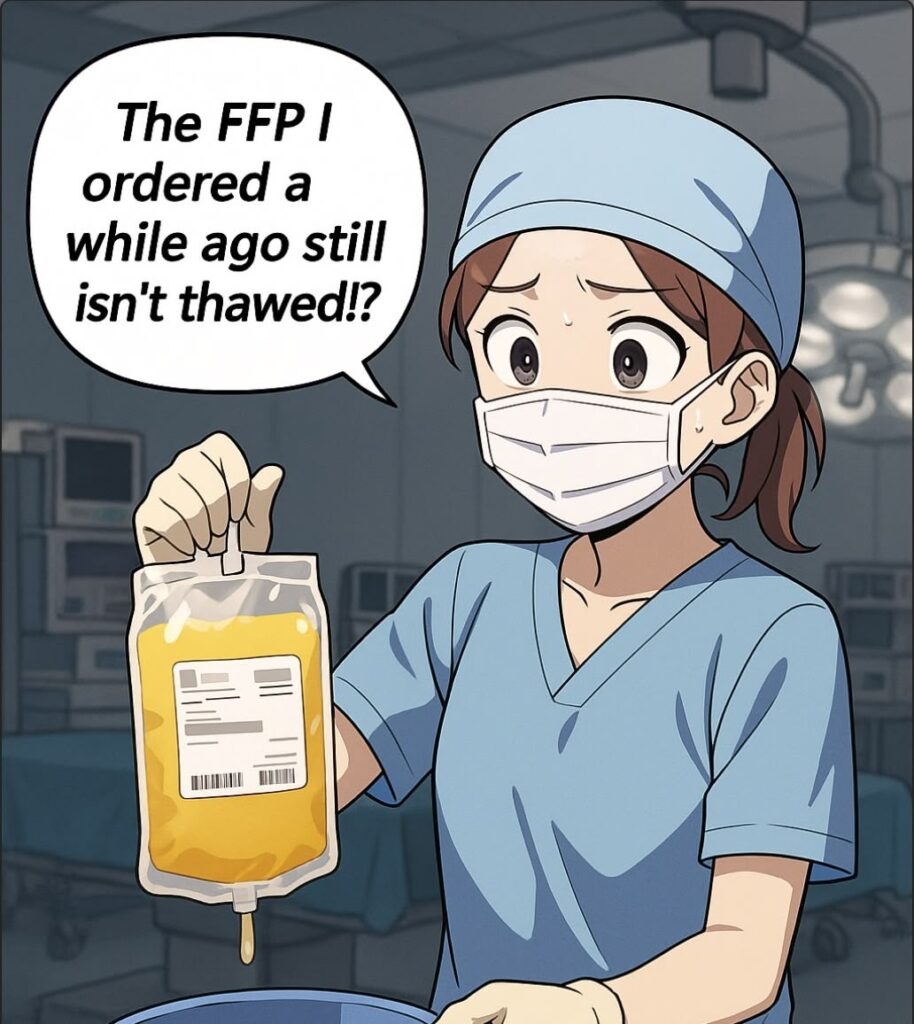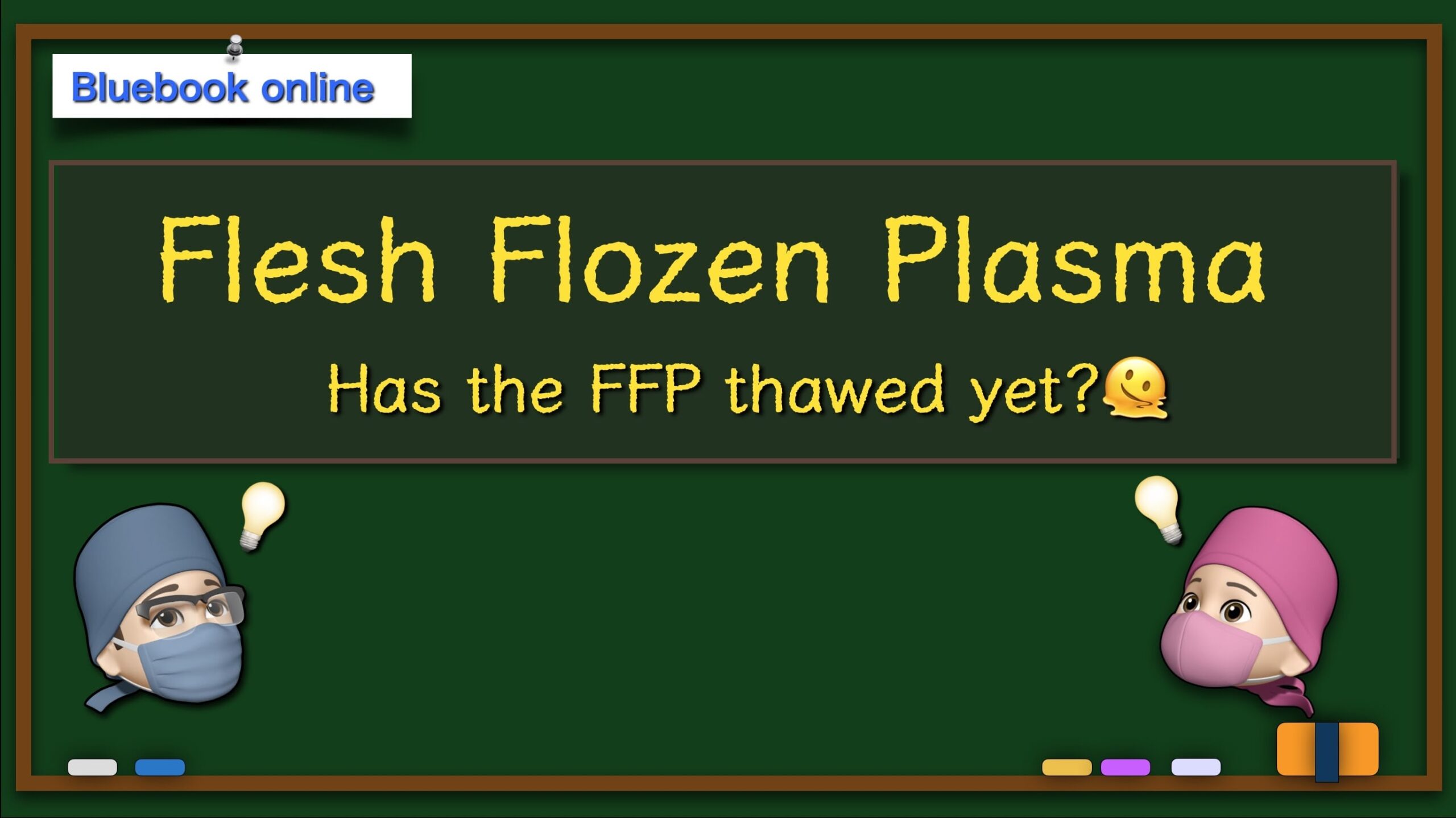👉👉 🇺🇸 All Posts 🇬🇧 / 🇯🇵 記事一覧 🇯🇵 👈👈
♦️ Introduction
 さらりーまん
さらりーまんIn cardiac surgery it’s always prepared in advance, but when unexpected bleeding happens, we’re always behind in ordering… and it never thaws quickly.



And then surgeons shout, ‘Why is transfusion so late!?’ even though we weren’t the ones who caused the bleeding. I hate that.



Hey, no badmouthing other departments. 👍
The FFP I ordered a while ago still isn’t thawed!?
🔷 What is FFP (Fresh Frozen Plasma)?
FFP, often nicknamed “white” in the OR(※ in japan), stands for Fresh Frozen Plasma. If you’re involved in cardiac or major surgeries, you’ve probably seen it almost every day.
🔷 Characteristics
FFP comes in various sizes, from 1 unit to 5 units. In Japan, the most commonly used product is the 2-unit pack (about 240 mL, derived from a 400 mL donation)
The definition of a “unit” differs by country. In Japan, a 2-unit pack (≈240 mL) is roughly equivalent to what is considered 1 unit (200–250 mL) in the US and many European countries.
In Japan, the official reimbursement price is around ¥17,000 per 2 units (as of 2025). Prices vary widely depending on the health care system, so this number should only be taken as a reference in the Japanese context.
The product appears pale yellow and is stored at −20 °C or below for up to 1 year. Freezing prevents enzymes in plasma from degrading clotting factors.
🔷 Thawing
Before use, FFP is thawed in warm water (30–37 °C) for 20–30 minutes. Once thawed, it must be used within 3 hours because clotting factor activity declines rapidly.


Why do we use it?
Simply put, to replace clotting factors when coagulation ability is impaired.
🔷 Major causes of coagulopathy
- Hematologic disorders: congenital or acquired factor deficiencies
- Liver dysfunction: impaired synthesis of clotting factors and platelets
- Anticoagulants: warfarin, heparin, and others
- Massive bleeding: especially during surgery — this is the most common reason
🔷 How is it used clinically?
Coagulation status is usually monitored with PT/INR, APTT, and fibrinogen levels. Patients with prosthetic heart valves, atrial fibrillation, or a history of stroke often have these values checked regularly for anticoagulation management.
General thresholds in Japan:
- Fibrinogen ≲ 100 mg/dL
- PT-INR ≳ 2.0 (≈1.5× normal PT)
- APTT ≳ 2× normal
International practice:
- Thresholds are broadly similar worldwide.
- In the US and many guidelines, PT-INR > 1.5 is often considered a trigger for FFP transfusion.
- For fibrinogen, some European guidelines recommend transfusion when levels fall below 100–150 mg/dL, and in the context of major bleeding, a higher target (keeping fibrinogen >150–200 mg/dL) may be used.
- For APTT, a clear universal threshold is less well defined, but “≈2× normal” prolongation is often used as a guide.
Typical perioperative scenarios include:
- Persistent microbleeding during cardiac or liver surgery
- Disseminated intravascular coagulation (DIC)
- Massive hemorrhage (blood loss equal to or greater than circulating volume)
- Emergency surgery in patients on warfarin, when rapid reversal is required
Additional Points
Clinical bleeding usually occurs only when clotting factor activity falls to ~20–30%. Even with massive hemorrhage, ~30–40% activity may remain, so FFP is not always immediately required. Still, in uncontrolled bleeding, you need to order early — because the more urgent it is, the slower it seems to thaw! 😡💢
As a reference, in a 60 kg patient, 6–7 units of FFP can increase clotting factor activity by about 30% and fibrinogen by ~30 mg/dL (approximate values).
✅ Take Home Points
- FFP = Fresh Frozen Plasma (“white”) → used to replace clotting factors.
- Storage & Thawing: −20 °C for ~1 year; thaw in 20–30 min; must use within 3 h.
- Purpose: corrects coagulopathy due to hematologic disorders, liver failure, anticoagulants, or massive bleeding.
- Indicators: fibrinogen ≲ 100 mg/dL, PT-INR ≳ 2.0, APTT ≳ 2× normal (general guides).
- Clinical use: cardiac/liver surgery, DIC, massive hemorrhage, emergency reversal of warfarin.
- Pearl: order early — urgent cases always feel like the slowest to thaw!
🔗 Related articles
- Autologous Blood Transfusion Explained: What You Need to Know Before Surgery
- Platelet Transfusion — Why Do We “Shake” Platelet Concentrates?
- Red Blood Cell Transfusion (RCC) ~Will the bleeding stop? Surgeon says yes… Anesthesiologist says 🤔~
- What Are Blood Types A, B, O, and AB?
- Type & Screen, Crossmatch, and Antibodies – Can You Explain Them?
- What do the labels “Ir” and “LR” on blood products mean?

コメントを投稿するにはログインしてください。